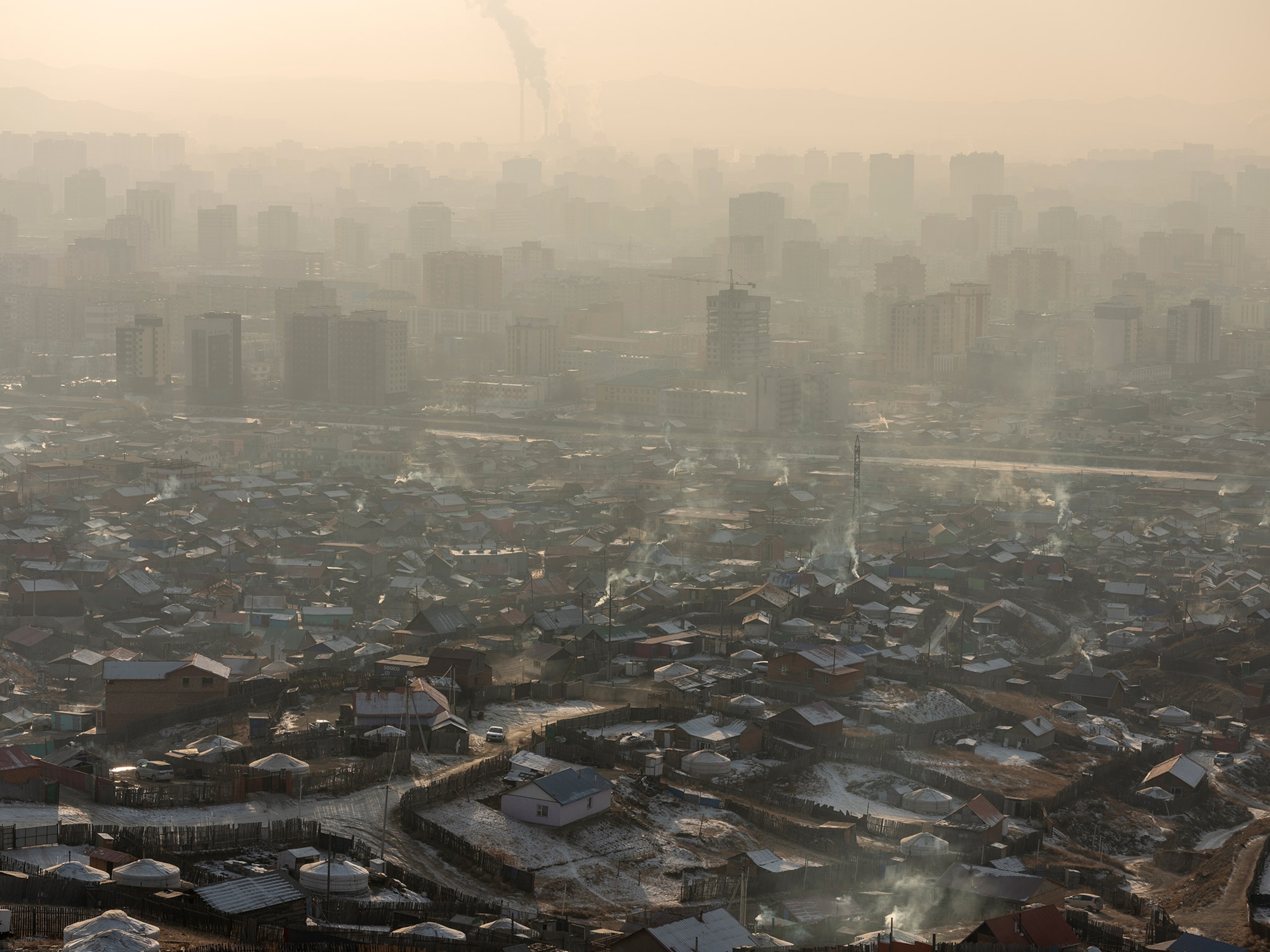
Can air pollution cause inflammation? Scientists are starting to unravel the connection.
A growing body of research is showing how breathing polluted air impairs the immune system’s ability to regulate inflammation—and leads to other serious health conditions.
Air quality has long been a concern in South Philadelphia, where an oil refinery operated for more than 150 years before an explosion set it on fire in 2019.
Today, many people in the densely populated, low-income, high-minority neighborhood have asthma, cancer, cardiovascular disease, rheumatoid arthritis, diabetes, and other conditions, “all of which operate through an inflammatory path,” says Jane Clougherty, an environmental epidemiologist at Drexel University in Philadelphia, who is working on a study to monitor air quality during the disassembling of the refinery.
Chronic exposure to air pollution causes inflammation and raises the risk for a variety of health problems, according to a large and growing body of research. As more climate change-caused wildfires belch smoke and roads fill with ever more fossil-fuel-burning vehicles, scientists are starting to unravel the details of how breathing air filled with pollution impairs the immune system’s ability to regulate inflammation.
The research has implications for both health care and health policy, experts say, emphasizing the need for stronger regulations to reduce air pollution, clearer guidelines to protect people from exposures with alerts about when to wear masks or stay indoors, and more research to intervene in the harm caused by air pollution.
“We can see on the news every day that air pollution is a big problem for every country,” says Juan C. Hernandez, an immunologist at the Cooperative University of Colombia in Medellín. “It is very important to know what the real effects of these pollutants are on our health.”
Bad air
Air pollution encompasses a range of gasses and particles of varying size and composition that can come from a variety of sources: cars and factories that burn fossil fuels like gas and oil, and natural phenomena such as wildfires, volcanoes, and sandstorms. Components of air pollution include sulfur dioxide, ozone, lead, and particulate matter that is categorized by size, including PM2.5 and PM10. Burning fossil fuels also emits toxic chemical substances. Regularly breathing in these pollutants can lead to health problems, according to many studies that have linked chronic exposure to air pollution with respiratory and cardiovascular diseases, neurological problems, cancers, and premature death.
Living with pollution can make people more vulnerable to infectious diseases, possibly including COVID-19. Multiple studies since 2020 have pointed to potentially higher rates of infection, complications and death from COVID in places with higher levels of air pollution, even when it was temporary. From March to December 2020, one analysis found, there were some 20,000 extra COVID infections and 750 extra deaths in parts of California, Oregon, and Washington States that experienced wildlife haze. Wildfires produce a lot of small particles, called PM2.5 because they act aerodynamically like particles with a diameter of 2.5 microns or less. (There are about 25,000 microns in an inch). Long-term exposure to even small amounts of PM2.5, another study found, was linked to an 8 percent increase in the risk of death from COVID.
Breathing in bad air activates inflammation, Clougherty says. When a particle of pollution enters the body, the innate immune response kicks into gear, leading to the production of cytokines and other molecules that produce inflammation in order to fight off the invader. Viruses and other foreign invaders also cause inflammatory reactions, but unlike viruses, particles can also become physically lodged in the lungs, where they continue to induce the production of inflammatory molecules. Pollution can also deliver metals and other substances into the bloodstream, and those can have toxic effects.
While a one-time exposure that causes inflammation is a sign of the body doing what it’s supposed to do, it can still cause harm. Bigger concerns come from ongoing assaults. “Acute exposure is bad,” Clougherty says. “Pile them on top of each other, and it's worse.”

Immune dysregulation
Although studies have shown higher levels of inflammatory molecules circulating in the blood of people with long-term exposure to different kinds of air pollution, understanding the details has been complicated by the natural variation that happens in the immune system on a daily basis, Clougherty says. If someone is fighting a cold, didn’t sleep well, or is feeling particularly stressed, they are likely to have elevated levels of molecules used to mark inflammation, such as cytokines and C-reactive protein, or CRP.
To get a clearer look at the interaction between air pollution and inflammation without all the noise that comes from life’s fluctuations, Clougherty and colleagues took blood from a cohort of middle-aged and older people in the Pittsburgh area who’d had varying exposures to air pollution. In the lab, they were then able to show that the cells of people with prior long-term exposure to PM 2.5 and black carbon emissions produced higher levels of certain inflammatory molecules when the researchers stimulated an immune reaction. They elicited particularly strong responses from people who had long been breathing in particles containing lead, iron, manganese, and zinc—metals associated with steelmaking operations.
Those results suggest that the immune systems of people with chronic exposure to air pollution might be reacting with a dysregulated immune response when presented with a threat. That inflammatory response could, in turn, lead to heart and lung diseases and other problems. “What we might be seeing here is hyper-inflammation,” Clougherty says. “You want enough of it to fight what you need to fight without it going out of control.”
Particles of varying sizes and gases like ozone each enter and move through the bodies in different ways, Hernandez and colleagues found in a 2021 study. But once any of these substances get inside the respiratory tract, blood, and other organs, effects become layered and interrelated. Both small and large particles, for example, can damage and kill cells in the lungs via inflammatory processes, Hernandez has found in his studies with animals and with cells in lab experiments. Cell death, in turn, induces more inflammation. As damage, contaminants, and inflammation accumulate, risks rise for chronic illnesses and respiratory infections by compromising the immune response.
Scientists are now using advanced technologies known as “-omics,” as well as next-generation gene sequencing, to look at the activity of hundreds of genes at once. That work is helping them to understand the exact molecules involved in the progression from air pollution exposure to inflammation, and how those molecules interact with each other, Hernandez says. The work could eventually lead to drugs that might interrupt the process and protect the lungs.



Affecting people differently
The impact of air pollution on health is an equity issue, Clougherty adds. In the United States, people of color and low-income earners are more likely to live and work near highways and industrial areas, often because costs are lower. But levels of air pollution are higher. The same groups also experience higher rates of diseases like diabetes that exacerbate assaults on their immune systems, and they face systemic barriers against inflammation-lowering behaviors, like exercise, sleep, and a good diet.
Research Clougherty and colleagues conducted more than 15 years ago with hundreds of children in Boston found that adversity magnifies a documented link between traffic-related air pollution and asthma in kids. Among children living with the same levels of nitrogen dioxide—a gas emitted by the burning fossil-fuels—only those who had been exposed to violence had an uptick in asthma diagnoses, suggesting that their immune systems were compromised by the stress, making them more vulnerable to the effects of air pollution. She has since replicated the pattern in rats and is investigating how chronic stressors might worsen air pollution’s effects on other diseases, too.
Addressing issues like violence alongside efforts to reduce air pollution could work together to alleviate the health consequences of both, she says. “Reducing one or the other gives us more policy levers with which to be able to improve public health and well-being,” Clougherty says, “and addressing both would give us optimal benefit.”

Policy action is also needed to reduce the source of the problem, says Clougherty. She was on a panel of experts that compiled research for the U.S. Environmental Protection Agency, which is reviewing its standards for the safety level of fine particles in the air. Based on the latest data, she says, the agency might end up lowering them.
Air pollution is a global problem, and we all share the same air, Hernandez says. By documenting the effects of the problem, he hopes that policymakers everywhere will take notice of how air pollution is affecting inflammation, health, and life on our planet. “The best path is the more difficult one—to show the policymakers the consequences of this pollution,” he says, “not only for human health but the health of the environment and the health of the animals.”
Related Topics
You May Also Like
Go Further
Animals
- How can we protect grizzlies from their biggest threat—trains?How can we protect grizzlies from their biggest threat—trains?
- This ‘saber-toothed’ salmon wasn’t quite what we thoughtThis ‘saber-toothed’ salmon wasn’t quite what we thought
- Why this rhino-zebra friendship makes perfect senseWhy this rhino-zebra friendship makes perfect sense
- When did bioluminescence evolve? It’s older than we thought.When did bioluminescence evolve? It’s older than we thought.
- Soy, skim … spider. Are any of these technically milk?Soy, skim … spider. Are any of these technically milk?
Environment
- Are the Great Lakes the key to solving America’s emissions conundrum?Are the Great Lakes the key to solving America’s emissions conundrum?
- The world’s historic sites face climate change. Can Petra lead the way?The world’s historic sites face climate change. Can Petra lead the way?
- This pristine piece of the Amazon shows nature’s resilienceThis pristine piece of the Amazon shows nature’s resilience
- Listen to 30 years of climate change transformed into haunting musicListen to 30 years of climate change transformed into haunting music
History & Culture
- Meet the original members of the tortured poets departmentMeet the original members of the tortured poets department
- Séances at the White House? Why these first ladies turned to the occultSéances at the White House? Why these first ladies turned to the occult
- Gambling is everywhere now. When is that a problem?Gambling is everywhere now. When is that a problem?
- Beauty is pain—at least it was in 17th-century SpainBeauty is pain—at least it was in 17th-century Spain
Science
- Should you be concerned about bird flu in your milk?Should you be concerned about bird flu in your milk?
- Here's how astronomers found one of the rarest phenomenons in spaceHere's how astronomers found one of the rarest phenomenons in space
- Not an extrovert or introvert? There’s a word for that.Not an extrovert or introvert? There’s a word for that.
- NASA has a plan to clean up space junk—but is going green enough?NASA has a plan to clean up space junk—but is going green enough?
Travel
- This tomb diver was among the first to swim beneath a pyramidThis tomb diver was among the first to swim beneath a pyramid
- Dina Macki on Omani cuisine and Zanzibari flavoursDina Macki on Omani cuisine and Zanzibari flavours
- How to see Mexico's Baja California beyond the beachesHow to see Mexico's Baja California beyond the beaches
- Could Mexico's Chepe Express be the ultimate slow rail adventure?Could Mexico's Chepe Express be the ultimate slow rail adventure?







